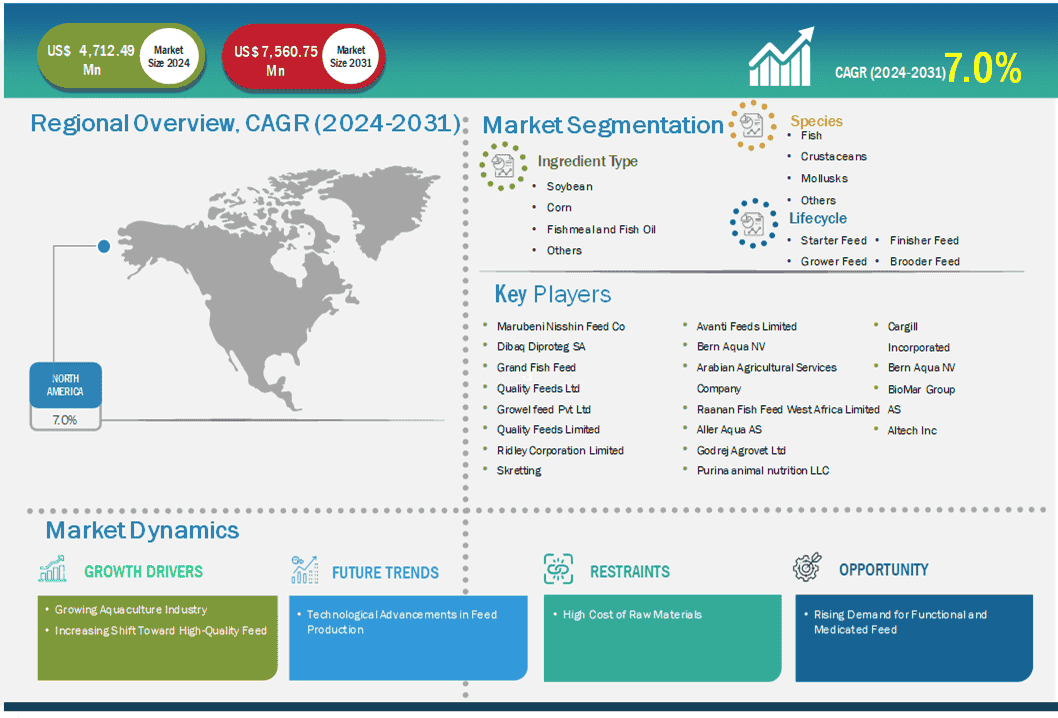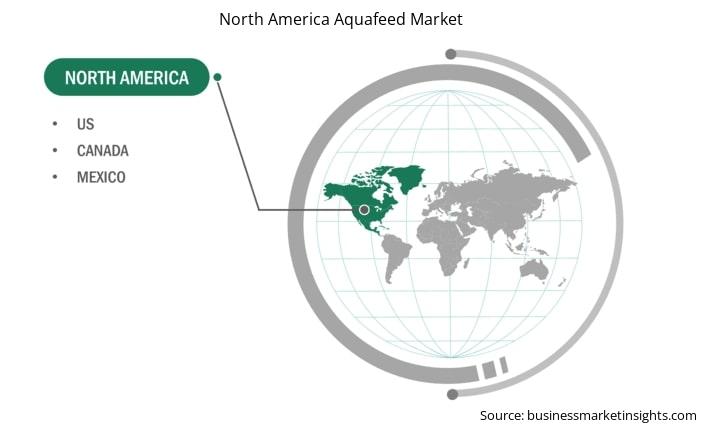North America Aquafeed Market Report (2021-2031) by Scope, Segmentation, Dynamics, and Competitive Analysis
No. of Pages: 198 | Report Code: BMIRE00031879 | Category: Food and Beverages
No. of Pages: 198 | Report Code: BMIRE00031879 | Category: Food and Beverages
The North America aquafeed market size is expected to reach US$ 7,560.75 million by 2031 from US$ 4,712.49 million in 2024. The market is estimated to record a CAGR of 7.0% from 2024 to 2031.
The North America aquafeed market is witnessing significant growth, driven by the increasing demand for aquaculture products and the growing awareness about the benefits of high-quality feed in enhancing aquatic animal health and productivity. The increasing reliance on aquaculture to meet the region's rising seafood consumption is driving the demand for aquafeed. As wild fish stock faces depletion and environmental pressures, aquaculture has emerged as a sustainable and efficient method to address the gap in seafood supply. This has led to a surge in demand for high-quality aquafeed that ensures optimal growth, nutrition, and health of aquatic species such as fish, crustaceans, and mollusks. The growing preference for nutrient-rich and sustainably farmed seafood among health-conscious consumers is further driving the adoption of advanced aquafeed solutions. Advancements in aquaculture technology and practices have led to increased production efficiency and sustainability. According to the United States Department of Agriculture, in 2023, there were 3,453 aquaculture farms with sales in the US, up 18% from 2018. This has encouraged further growth in the aquaculture industry, increasing the demand for aquafeed. Thus, the demand for aquafeed in North America is driven by a combination of factors, including increasing global demand for seafood, advancements in aquaculture technology, growing consumer awareness of sustainability, and a focus on food safety and quality.

Key segments that contributed to the derivation of the aquafeed market analysis are ingredient type, species, and lifecycle.
The rising incidence of disease outbreaks in aquaculture systems has highlighted the critical need for effective nutritional solutions, driving the demand for functional and medicated feeds. Functional feeds, enriched with probiotics, prebiotics, and immune-boosting additives, play a vital role in enhancing the health and resilience of farmed aquatic species. These feeds improve gut health, optimize nutrient absorption, and strengthen the immune system, reducing the risk of diseases and mortality in aquaculture operations.
In addition to functional feeds, medicated feeds designed to target specific diseases present a significant growth opportunity in the global aquafeed market. These feeds are formulated with therapeutic agents to treat or prevent diseases caused by bacterial, fungal, or parasitic infections, which are prevalent in intensive farming systems. With disease outbreaks posing a significant threat to aquaculture productivity and profitability, the adoption of such feeds has become increasingly essential.
Moreover, the growing focus on sustainable aquaculture practices has driven interest in natural additives and bioactive compounds as alternatives to antibiotics, aligning with regulatory restrictions and consumer preferences for antibiotic-free seafood. As aquaculture systems become more intensive and disease management becomes a priority, functional and medicated feeds are expected to play a crucial role in shaping the future of the aquafeed market
Based on country, the North America Aquafeed Market comprises the US, Mexico, and Canada. The US held the largest share in 2024.
The aquafeed market in the US has emerged as a dynamic and rapidly growing segment of the broader animal feed industry, driven by the increasing demand for seafood and the expansion of aquaculture. According to the US Department of Commerce, in 2022, the estimated freshwater and marine aquaculture production was 300.68 million metric tons, with a value of US$ 1.7 billion, reflecting growth in this sector. While aquaculture only accounts for 7% of total domestic seafood production, the focus on high-value products means that 23% of the value of seafood products comes from aquaculture. In addition, according to the National Aquaculture Association, aquaculture farmers in the US produce ~1,500 different aquatic species for various purposes using numerous systems and methods. According to the USDA, aquaculture contributes US$ 4 billion annually to the US economy and provides more than 22,000 jobs, primarily in economically disadvantaged areas such as rural communities and working waterfronts. As consumers shift toward healthier dietary choices and sustainable food sources, the aquaculture industry has grown significantly, necessitating the production of high-quality, nutritionally balanced aquafeeds. The market is supported by advanced feed manufacturing technologies and a strong focus on research and development, ensuring that the nutritional needs of various aquatic species are met effectively. With the rising popularity of farmed seafood and increasing investments in aquaculture infrastructure, the US aquafeed market is poised for steady growth in the coming years.
| Report Attribute | Details |
|---|---|
| Market size in 2024 | US$ 4,712.49 Million |
| Market Size by 2031 | US$ 7,560.75 Million |
| CAGR (2024 - 2031) | 7.0% |
| Historical Data | 2021-2023 |
| Forecast period | 2025-2031 |
| Segments Covered |
By Ingredient Type
|
| Regions and Countries Covered | North America
|
| Market leaders and key company profiles |
|
Some of the key players operating in the market include Cargill, Incorporated; World Feeds Limited; Kemin Industries Inc; Archer-Daniels-Midland Co; Alltech Inc; BioMar Group AS; Purina Animal Nutrition LLC; Godrej Agrovet Ltd; Aller Aqua AS; Raanan Fish Feed West Africa Limited; Arabian Agricultural Services Company; Bern Aqua NV; Avanti Feeds Limited; Skretting; Ridley Corporation Limited; Growel Feeds Pvt Ltd; Quality Feeds Limited; Grand Fish Feed; Dibaq Diproteg SA; and Marubeni Nisshin Feed Co Ltd among others. These players are adopting various strategies such as expansion, product innovation, and mergers and acquisitions to provide innovative products to their consumers and increase their market share.
The following methodology has been followed for the collection and analysis of data presented in this report:
The research process begins with comprehensive secondary research, utilizing both internal and external sources to gather qualitative and quantitative data for each market. Commonly referenced secondary research sources include, but are not limited to:
Note: All financial data included in the Company Profiles section has been standardized to USD. For companies reporting in other currencies, figures have been converted to USD using the relevant exchange rates for the corresponding year.
The Insight Partners’ conducts a significant number of primary interviews each year with industry stakeholders and experts to validate its data analysis, and gain valuable insights. These research interviews are designed to:
Primary research is conducted via email interactions and telephone interviews, encompassing various markets, categories, segments, and sub-segments across different regions. Participants typically include:

The North America Aquafeed Market is valued at US$ 4,712.49 Million in 2024, it is projected to reach US$ 7,560.75 Million by 2031.
As per our report North America Aquafeed Market, the market size is valued at US$ 4,712.49 Million in 2024, projecting it to reach US$ 7,560.75 Million by 2031. This translates to a CAGR of approximately 7.0% during the forecast period.
The North America Aquafeed Market report typically cover these key segments-
The historic period, base year, and forecast period can vary slightly depending on the specific market research report. However, for the North America Aquafeed Market report:
The North America Aquafeed Market is populated by several key players, each contributing to its growth and innovation. Some of the major players include:
The North America Aquafeed Market report is valuable for diverse stakeholders, including:
Essentially, anyone involved in or considering involvement in the North America Aquafeed Market value chain can benefit from the information contained in a comprehensive market report.